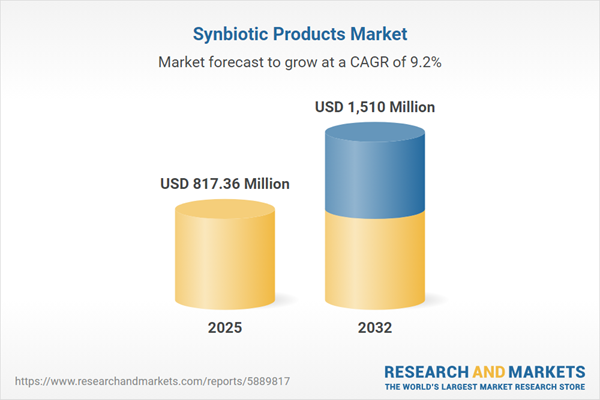Speak directly to the analyst to clarify any post sales queries you may have.
Senior executives face a dynamic synbiotic products market, marked by shifting consumer preferences, stricter regulatory frameworks, and expanding international competition. Decision-makers must stay agile and data-driven to capture innovation opportunities and meet rising customer expectations in the evolving health and nutrition landscape.
Market Snapshot: Synbiotic Products Market Size and Growth Outlook
The synbiotic products market is projected to expand from USD 748.34 million in 2024 to USD 817.36 million in 2025, achieving USD 1.51 billion by 2032, with a CAGR of 9.20%. Growth is driven by scientific advancement and strong global demand for solutions supporting digestive and immune health across both human and animal applications. Market participants who quickly integrate these trends can address emerging wellness needs in multiple regions. Sustained innovation, preventive consumer mindsets, and increasing applications are expected to further support robust growth. Leaders are challenged to realign strategies quickly amidst regulatory shifts and heightened competition.
Scope & Segmentation
- Product Types: Encompasses animal feed, dietary supplements, functional foods and beverages, and pharmaceuticals. This diversity allows organizations to address specialty needs, from pet nutrition and veterinary care to clinical therapeutics and everyday wellness maintenance.
- Applications: Includes digestive health, immunity, and weight management. Solutions in each category are tailored to core consumer health priorities and leverage the ongoing shift toward preventive care, directly impacting investment direction and product pipelines.
- End Users: Covers both human and animal populations. The dual focus draws in stakeholders ranging from veterinary experts and pet industry leaders to formulators working on consumer dietary health products, expanding the market's breadth.
- Distribution Channels: Spans pharmacies, drug stores, specialty retailers, supermarkets, hypermarkets, branded company websites, large e-commerce portals, online marketplaces, and subscription-based models. This variety supports flexible go-to-market strategies and targeted sales approaches to reach both professionals and end consumers.
- Dosage Forms: Offers capsules, gummies, liquid, and powder formats. Multiple delivery systems enable improved user experience, address flavor and texture preferences, and promote adherence across consumer and clinical audiences.
- Key Regions: Includes Americas, Europe, Middle East and Africa, and Asia-Pacific, focusing particularly on markets such as China, India, and Australia. Adapting to regulatory nuances and regional wellness trends is essential for achieving compliance and local market traction.
- Leading Companies: Highlights strategic players like Danone S.A., Yakult Honsha Co., Ltd., Nestlé S.A., Chr. Hansen Holding A/S, Kerry Group plc, International Flavors & Fragrances Inc., Koninklijke DSM N.V., Lallemand Inc., Probi AB, and Synbiotics, LLC, each contributing to research leadership, manufacturing strength, and expansive partnerships.
Key Takeaways: Strategic Insights for Senior Decision-Makers
- Precision in synbiotic product formulation and innovative encapsulation methods facilitates the delivery of specialized solutions for targeted human and veterinary health requirements.
- Stronger alliances with research institutions and universities enhance scientific credibility, paving the way for successful product authorization processes and building customer confidence.
- Heightened regulatory complexity across global markets necessitates continuous investment in document management, compliance validation, and support for permissible health claims, all affecting speed to market.
- Supply chain verification, enabled by new technologies such as blockchain, and the use of third-party certifications, are now essential for market trust and regulatory acceptance.
- Direct-to-consumer and digitally enabled sales models are redefining traditional marketplace dynamics, yielding better buyer intelligence and loyalty avenues for professional purchasers and consumer segments alike.
- Success increasingly depends on adaptive product localization strategies that consider both regional health preferences and evolving policy environments.
Tariff Impact: United States Policy Changes
Recent adjustments to U.S. tariff policy have elevated cost pressures on imported probiotic and prebiotic ingredients. Many businesses are responding by sourcing ingredients from diversified suppliers, stepping up investment in regional facilities, and reconstructing logistics models. These proactive approaches support stability, product quality, and competitive consistency as trade regulations evolve.
Synbiotic Products Market: Methodology & Data Sources
This market analysis draws on rigorously peer-reviewed scientific literature, detailed interviews with key industry leaders, and integrated laboratory and commercial data. Reliability has been reinforced through independent audits and robust validation procedures, delivering a dependable foundation for executive-level decisions.
Why This Report Matters
- Gives executives benchmarking frameworks to manage innovation, address compliance, and reinforce supply chain resilience, enhancing responsiveness in uncertain conditions.
- Offers actionable segmentation insights and regional reviews to optimize partner selection and support focused go-to-market strategies throughout varying opportunity landscapes.
- Enables strategic planning and risk mitigation for tariff and regulatory changes, supporting sustainable operations and long-term business continuity.
Conclusion
The synbiotic products market is rapidly evolving with advancements in science, digital tools, and resilient supply frameworks. Informed, validated strategies are essential for organizations seeking to capitalize on new market opportunities and drive sustainable growth.
Additional Product Information:
- Purchase of this report includes 1 year online access with quarterly updates.
- This report can be updated on request. Please contact our Customer Experience team using the Ask a Question widget on our website.
Table of Contents
3. Executive Summary
4. Market Overview
7. Cumulative Impact of Artificial Intelligence 2025
Samples

LOADING...
Companies Mentioned
The key companies profiled in this Synbiotic Products market report include:- Danone S.A.
- Yakult Honsha Co., Ltd.
- Nestlé S.A.
- Chr. Hansen Holding A/S
- Kerry Group plc
- International Flavors & Fragrances Inc.
- Koninklijke DSM N.V.
- Lallemand Inc.
- Probi AB
- Synbiotics, LLC
Table Information
| Report Attribute | Details |
|---|---|
| No. of Pages | 188 |
| Published | October 2025 |
| Forecast Period | 2025 - 2032 |
| Estimated Market Value ( USD | $ 817.36 Million |
| Forecasted Market Value ( USD | $ 1510 Million |
| Compound Annual Growth Rate | 9.2% |
| Regions Covered | Global |
| No. of Companies Mentioned | 11 |









